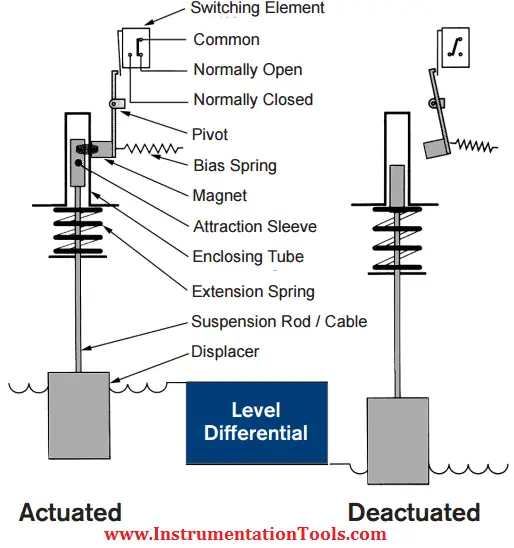Displacer controls offer alternative features to the float-operated control. The sensor is a weight (displacer), heavier than the liquid, that is suspended by a spring. When liquid contacts the displacer, a buoyancy force is produced, which causes the effective weight of the displacer to change. This causes the spring to retract slightly to a new equilibrium position. When the spring retracts, the attraction sleeve also moves upward into the field of the external magnet, thus overcoming the force of the bias spring and actuating the switching element.

This principle provides for narrow or wide switching differential, and allows switching point alteration by moving the displacer(s) up or down the suspension cables.
Displacers may be arranged in combinations of narrow and wide differential to operate up to three switching stages. Displacer controls operate under higher pressure conditions than float-operated switches.
Applications: For wide switching differentials & higher pressure ratings. Used where traditional float operated units cannot work.
Floats v/s Displacers
Following are the major points of distinction between floats and displacers:
- “Float Switches are available with a glandless design and are capable of fail safe operation in extreme process conditions, unlike displacers, which if the torque tube fails can provide a leak path.”
- A float generally rides above the surface of liquid whereas a displacer remains either partly or totally immersed in process liquid.
- Displacer switches are considered to be additionally stable and dependable as compared to standard float level switches in case of turbulent, surging, frothy and foamy services. However in case of refineries, the use of displacers is decreasing owing to their high installation cost and inaccurate performance due to process density changes. In these applications, float level switches have been found to be reliable and useful.
- Settings of displacers can be changed very easily since they can be shifted at any place along the length of the suspension cable. Moreover, these level devices have the provision of interchangeability between tanks. This is due to the fact that the differences in process density can be endured by varying the tension of the spring attached to the displacers.
- Testing the appropriate working of a displacer switch is much easier than a customary float level switch since the former requires just lifting of a suspension whereas the latter necessitates filling of liquid in the tank upto the actuation mark.
Also Read: Float Operated Level Switch Working Principle
What is a basic difference of pressure and flow